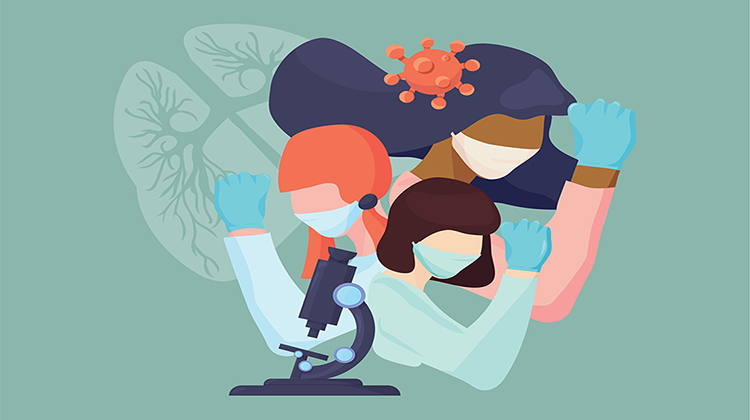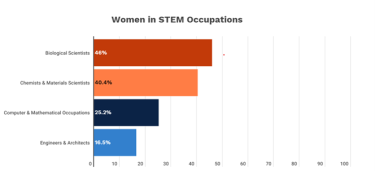Women in STEM with Lindsey Clarke: ‘everyone has half an hour’
Posted: 8 March 2023 | Izzy Wood (Drug Target Review) | No comments yet
For International Women’s Day, Drug Target Review’s Izzy Wood recently spoke to Lindsey Clarke about her experience as a woman in STEM.


According to American Association of University Women (AAUW),1 women make up only 28 percent of the workforce in science, technology, engineering and math (STEM), and men vastly outnumber women in most STEM fields. Gender gaps are particularly high in some of the fastest-growing and highest-paid STEM jobs of the future.
But what can we do about this?
I spoke to Lindsey Clarke about her experience as a woman in STEM, who shared her advice on navigating this environment.
Reduce preclinical failures with smarter off-target profiling
24 September 2025 | 15:00PM BST | FREE Webinar
Join this webinar to hear from Dr Emilie Desfosses as she shares insights into how in vitro and in silico methods can support more informed, human-relevant safety decisions -especially as ethical and regulatory changes continue to reshape preclinical research.
What you’ll learn:
- Approaches for prioritizing follow-up studies and refining risk mitigation strategies
- How to interpret hit profiles from binding and functional assays
- Strategies for identifying organ systems at risk based on target activity modulation
- How to use visualization tools to assess safety margins and compare compound profiles
Register Now – It’s Free!
Clarke has had a natural curiosity for science from an early age. Her career, starting 20 years ago, began with a degree in pharmacology and a subsequent PhD in immunology – where she got to spend time with clinicians and familiarise herself with the patient side of disease.
It was after a brief postdoc and the realisation that the academic path was not one for her that Clarke became affiliated with cell and gene therapy as a technical sales specialist, discovering that being involved with these therapies development could impact these diseases in a positive manner. She fell in love with the whole idea of being able to use cells to heal the body in all manner of ways. She has since worked in numerous roles on the tools and technology side of the cell and gene therapy.
More recently, Clarke has cofounded a networking platform for women in STEM called The CGT Circle. Her idea behind this is to help women in the industry build out a local support network in the clusters of the cell and gene therapy industry across the globe, where there are likely plenty of women across the smaller companies in the space but they may not know each other.
She explains that there could be women working on the same campus that have no idea that there is someone probably having similar challenges and experiences to them, at a different company who they could have a cup of coffee with and talk about it.
I am a huge believer in if I can see it, I can be it
“We need to be having those cups of coffee with other women in similar situations to us as we progress our careers in our life. I think open and honest conversation is something that is really valuable”.
Obstacles faced by women in STEM
During our conversation, Clarke shared her opinion about the unique challenges faced by women in STEM, and the drug discovery industry.
“We have different needs at different stages in our careers. The statistics will show as you progress up through towards leadership that women are dropping off, whether it’s in STEM or whether it’s just in corporate in general.”


(SOURCE: US Bureau of Labour Statistics, “Employed persons by detailed occupation, sex, race, and Hispanic or Latino ethnicity,” Labour Force Statistics from the Current Population Survey, Table 11, 2020).
“We are seeing a lot more women progressing their careers and working out that it is all about balance and compromise; but a lot are still being left behind, we should be leveraging the strengths and talent pool we have, not losing it, we are missing out on so much talent. If we can make work, work, (which is a campaign I am seeing a lot at the moment), then there’s a lot of talent out there that we can keep.”
It is clear that women in this field lack representation or are perhaps overlooked. When asked “What steps do you think can be taken to increase the representation of women, particularly in the STEM field?”, Clarke answered:
“I am a huge believer in if I can see it, I can be it. I have had some phenomenal role models at all different stages of my career, having that support early on in your career when you are potentially doubting yourself, can do a great deal. To have a role model that actually normalises some of these challenges we experience would be very beneficial.”
Mentoring and role models
Clarke has started using the phrase ‘everyone has half an hour’. She has been involved formally as a mentor for the last few years, finding the experience rewarding through seeing some of her female colleagues grow and gain confidence in themselves.
‘Everyone has half an hour’ encourages a community in which women can reach out to each other in an informal manner, connecting with their peers in the industry.
Clarke explained: “I think everyone has got half an hour. That is a phrase that we are trying to get out in the CGT circle. Do not be afraid to reach out to people because a lot of us want to see the next generation coming through and support them. I have always been very open to this kind of idea of informal mentoring. If you can grab 30 minutes with one of the senior women in the industry that you admire, you are going to learn so much from them”.
Thus, building this network is important, not only for support but to have clear role models in a position of leadership.
Clarke continued to describe how these connections can always come in handy when you need some advice or support.
“When you’re in the lab and you are head down and you’re focusing on your research you don’t think about that wider network, that wider opportunity out there. These external networks to your organisation are so valuable from a support perspective. When you have got the network, people will come looking for you if they know you. It is a lot of word of mouth, particularly in cell and gene because it is such a small industry. So again, being exposed to that much earlier in your career would be really helpful.”
Women in leadership
Drugs companies and the pharmaceutical industry would benefit from having greater diversity and inclusion, particularly in these leadership roles, but how can this be achieved?
Clarke expressed: “I think the statistics just show it. You just need to look at any of the reports that have examined this, that show that basically the greater diversity you have within leadership, within top teams, within management, the more successful businesses are. That is something that we all need to think about more”.
“When I build up my own teams, I think about everyone adding value to that team. Everyone’s got a different opinion, a different mindset, especially if they come from different backgrounds – if we can create a respectful culture in companies where that is appreciated, everyone can add value and I think inclusion then comes naturally”.
Clarke left me with some sage advice for young women in STEM, and how to step into these leadership roles: “If you think about your career as long and fluid, you must not be afraid of change. Every time you step into a new role, you will learn new things and experience adds up. I certainly would not be where I am today without having a particular circuitous route to get here through working in different places. Thus, there is no linear progression: you must do what works for you”.


Dr Lindsey Clarke
Lindsey is passionate about bringing new technologies to the cell and gene therapy sector that support and streamline translation and manufacturing.
A scientist by training she gained her PhD in Immunology from UCL and has postdoctoral experience in Bioengineering from Imperial College. Subsequently she has spent 12 years on the tools and technologies side of the industry in a variety of roles spanning technical sales, support and business development, product management, marketing and go-to-market strategy. Initially working at the bigger players Miltenyi Biotec and Bio-Techne, she has more recently been at Ori Biotech and later this year will be joining a startup in a commercial leadership role.
Currently Lindsey is putting her energies into establishing The CGT Circle – a women’s networking community she recently co-founded. The CGT circle’s mission is to decentralise networking for women working in the cell and gene therapy sector by supporting local community led efforts to help women in the industry build and foster meaningful connections.
She is enthusiastic about attracting and supporting the next generation of talent coming into the industry and is actively involved in mentoring and outreach efforts.
References:
- The stem gap: Women and girls in Science, Technology, engineering and Mathematics [Internet]. AAUW. 2022 [cited 2023Mar8]. Available from: https://www.aauw.org/resources/research/the-stem-gap/
Related topics
Cell Therapy, Drug Discovery
Related organisations
American Association of University Women (AAUW), Bio-Techne, Miltenyi Biotec, Ori Biotech, The CGT Circle, UCL
Related people
Dr Lindsey Clarke








